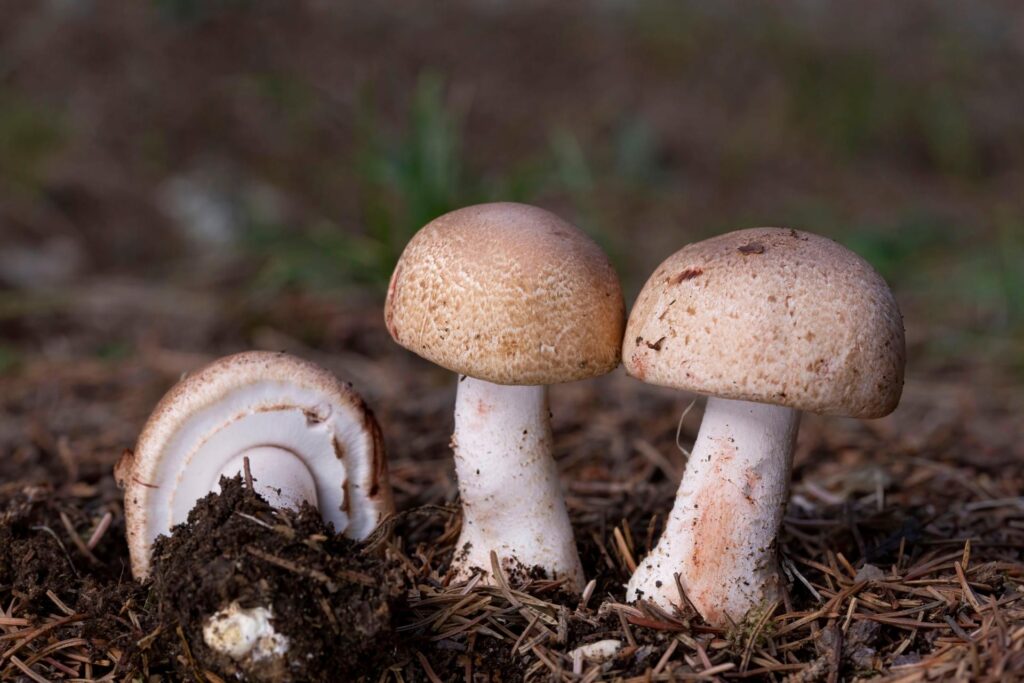In the lush, tropical highlands of Brazil, a small mushroom with a big reputation was quietly growing. Locals called it Cogumelo do Sol, or “Mushroom of the Sun.” Others referred to it as Cogumelo de Deus—“God’s Mushroom”—because of its remarkable ability to support vitality and resilience.
They didn’t need clinical studies to know it made a difference. Generations had used it in traditional preparations to feel stronger, more balanced, and more alive.
That mushroom, now known around the world as Agaricus blazei Murrill (ABM), has become one of the most researched and respected functional mushrooms for immune and cellular support. But how did this humble mushroom travel from a small village in Brazil to wellness clinics in Japan, and eventually to homes around the globe?
Let’s take a look at its remarkable journey—and why this mushroom is still capturing attention today.
Rooted in Brazilian Tradition
ABM was originally discovered in the mountainous region of Piedade, near São Paulo. There, it grew wild in rich, untouched soils near the Atlantic Rainforest. The local population had unusually good health for their time and were said to experience high vitality and longevity. Curious researchers eventually connected this to the frequent use of the local mushroom in food and traditional preparations.
It wasn’t long before word of this “God’s Mushroom” spread beyond Brazil’s borders.
Adopted in Japan, Studied Worldwide
In the 1960s and ’70s, Japanese scientists were the first to deeply study Agaricus blazei Murill. Among the most influential was Dr. Takeshi Mizuno, a pioneer in mushroom science whose early research focused on ABM’s polysaccharides, beta-glucans, and other health-supportive compounds. His work helped establish the foundation for decades of research to come.
Intrigued by its unique nutrient profile, Japanese researchers began cultivating ABM under controlled conditions and incorporating it into wellness practices. The mushroom gained rapid popularity for helping maintain immune balance, cellular function, and overall resilience.
Japan, Korea, and other countries in Asia began incorporating ABM into wellness practices, and the scientific literature has grown steadily ever since—thanks in large part to the groundwork laid by Dr. Mizuno and his team.
A Note on Hybridization
As global interest grew, ABM began being cultivated commercially outside of Brazil. However, most of these mushrooms are hybridized strains—altered genetically or selectively bred to withstand large-scale production. While this may support yield, it can also alter the mushroom’s original nutritional and energetic profile.
At Desert Forest Nutritionals®, we’ve stayed close to the source. We work with a trusted grower in Brazil who uses non-hybridized strains grown using traditional methods near the Atlantic Rainforest—the region where ABM originally grew wild.
A Mushroom With Over 190 Nutrients
What sets ABM apart is its rich spectrum of compounds. While many mushrooms offer health-supportive benefits, ABM stands out with over 190 identified nutrients—including antioxidants, enzymes, amino acids, minerals, and immunomodulatory polysaccharides.
This complexity is one reason researchers around the world continue to study it.
Still Relevant, Still Respected
Today, ABM mushrooms are grown in controlled environments near the Atlantic Rainforest, using traditional and sustainable methods. At Desert Forest Nutritionals®, we’ve been working with a small, trusted grower in Brazil since 2002. Our extracts come from the mature fruiting body only—never mycelium—and are created using a traditional dual-extraction method to capture the full spectrum of active compounds.
That’s how we honor the historToday, Agaricus blazei Murill (ABM) remains one of the most studied and trusted functional mushrooms. At Desert Forest Nutritionals®, we’ve been working with a small, trusted grower in Brazil since 2002—using traditional and sustainable methods near the Atlantic Rainforest. Our extracts come from non-hybridized, mature fruiting bodies only—never mycelium—and are made using a time-honored dual-extraction process to capture the full spectrum of active compounds.
We use no mycelium, no maltodextrin, and no shortcuts—just real mushrooms, processed the traditional way to preserve their full potency.
That’s how we honor the history of ABM—while supporting its continued relevance in modern wellness.
Bibliography
- Mizuno, T. (1995). Agaricus blazei Murill: medicinal and dietary effects and cultivation techniques. Food Reviews International, 11(1), 69–85.
→ Early, foundational review summarizing traditional use, polysaccharides, and medicinal value. - Firenzuoli, F., Gori, L., & Lombardo, G. (2008). The medicinal mushroom Agaricus blazei Murrill: review of literature and pharmaco‑toxicological problems. Evidence‑Based Complementary and Alternative Medicine, 5(1), 3–15.
- Hetland, G., Johnson, E., Lyberg, T., Bernardshaw, S., Tryggestad, A. M. A., & Grinde, B. (2008). Effects of the medicinal mushroom Agaricus blazei Murill on immunity, infection and cancer. Scandinavian Journal of Immunology, 68(4), 363–370.
- Takaku, T., Kimura, Y., & Okuda, H. (2001). Isolation of an antitumor compound from Agaricus blazei Murill and its mechanism of action. Journal of Nutritional Science and Vitaminology, 47(3), 145–149.
- Delmanto, R., de Lima, P. L., Sugui, M. M., et al. (2001). Antimutagenic effect of Agaricus blazei Murill mushroom on the genotoxicity induced by cyclophosphamide. Mutation Research, 496(1–2), 15–21.
- **Critical review on chemical compositions and health‑promoting effects of Agaricus blazei Murill** (Huang et al., 2022).
- Mizuno, T. (1995). Agaricus blazei Murill: medicinal and dietary effects and cultivation techniques. Food Reviews International, 11(1), 69–85.

